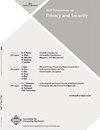重新审视生物识别认证系统对抗统计攻击的安全性
IF 2.8
4区 计算机科学
Q2 COMPUTER SCIENCE, INFORMATION SYSTEMS
引用次数: 1
摘要
行为生物特征(例如,语音或按键模式)的独特性受到了最近工作的挑战。已经提出了推断一般人口统计数据并针对特定受害者的行为生物特征的统计攻击。我们表明,尽管这些方法取得了成功,但由于用户对这些生物特征的行为重叠性质不同,因此需要多次尝试成功攻击不同的生物特征。此外,迄今为止还没有提出检测统计攻击的机制。在这项工作中,我们提出了一种新的基于超卷的统计攻击,并表明与现有方法不同,它(1)对各种生物特征都是成功的,(2)对更多的用户是成功的;(3)成功攻击所需的尝试最少。更具体地说,在五种不同的生物特征中,对于第一次尝试,我们的攻击平均比第二好的攻击成功18个百分点(37%对19%)。同样,在第五次进攻尝试中,我们的进攻平均比第二次进攻成功18个百分点(67%对49%)。我们提出并评估了一种可以检测更具破坏性的统计攻击的机制。生物识别系统中的虚假拒绝很常见,通过区分统计攻击和虚假拒绝,我们的防御提高了可用性和安全性。对所提出的检测机制的评估表明,其平均检测94%的测试统计攻击的能力,将错误拒绝检测为统计攻击的平均概率为3%。鉴于统计攻击对当今使用的生物识别技术(如语音)构成的严重威胁,我们的工作强调了防御这些攻击的必要性。本文章由计算机程序翻译,如有差异,请以英文原文为准。
Revisiting the Security of Biometric Authentication Systems Against Statistical Attacks
The uniqueness of behavioral biometrics (e.g., voice or keystroke patterns) has been challenged by recent works. Statistical attacks have been proposed that infer general population statistics and target behavioral biometrics against a particular victim. We show that despite their success, these approaches require several attempts for successful attacks against different biometrics due to the different nature of overlap in users’ behavior for these biometrics. Furthermore, no mechanism has been proposed to date that detects statistical attacks. In this work, we propose a new hypervolumes-based statistical attack and show that unlike existing methods, it (1) is successful against a variety of biometrics, (2) is successful against more users, and (3) requires fewest attempts for successful attacks. More specifically, across five diverse biometrics, for the first attempt, on average our attack is 18 percentage points more successful than the second best (37% vs. 19%). Similarly, for the fifth attack attempt, on average our attack is 18 percentage points more successful than the second best (67% vs. 49%). We propose and evaluate a mechanism that can detect the more devastating statistical attacks. False rejects in biometric systems are common, and by distinguishing statistical attacks from false rejects, our defense improves usability and security. The evaluation of the proposed detection mechanism shows its ability to detect on average 94% of the tested statistical attacks with an average probability of 3% to detect false rejects as a statistical attack. Given the serious threat posed by statistical attacks to biometrics that are used today (e.g., voice), our work highlights the need for defending against these attacks.
求助全文
通过发布文献求助,成功后即可免费获取论文全文。
去求助
来源期刊

ACM Transactions on Privacy and Security
Computer Science-General Computer Science
CiteScore
5.20
自引率
0.00%
发文量
52
期刊介绍:
ACM Transactions on Privacy and Security (TOPS) (formerly known as TISSEC) publishes high-quality research results in the fields of information and system security and privacy. Studies addressing all aspects of these fields are welcomed, ranging from technologies, to systems and applications, to the crafting of policies.
 求助内容:
求助内容: 应助结果提醒方式:
应助结果提醒方式:


